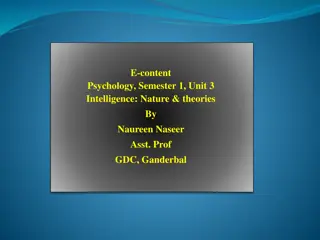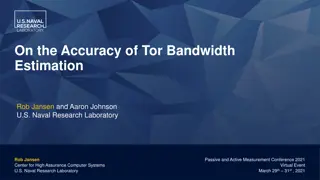Investigating Computational Intelligence: Reading What Machines Think at University of Rome Tor Vergata
Researchers at University of Rome Tor Vergata are delving into the intriguing realm of understanding and predicting human brain activity by observing cognitive tasks using computational machines. Their motivation lies in bridging the complexity of computers with the mysteries of the human brain, aiming to develop technologies that can read computer minds for various applications like detecting malicious software and hostile computer intentions.
- Computational Intelligence
- Brain Activity Prediction
- Machine Thinking
- University Research
- Cognitive Tasks
Download Presentation

Please find below an Image/Link to download the presentation.
The content on the website is provided AS IS for your information and personal use only. It may not be sold, licensed, or shared on other websites without obtaining consent from the author. Download presentation by click this link. If you encounter any issues during the download, it is possible that the publisher has removed the file from their server.
E N D
Presentation Transcript
Reading what Machines Think Fabio Massimo Zanzotto and Danilo Croce University of Rome Tor Vergata Roma, Italy
University of Rome Tor Vergata Prelude Question Tom Mitchell, Invited Talk at the Association for Computational Linguistics Conference 2007 This is a fascinating research problem. Can we find a more controlled setting where we can test if this is possible? Brain Activation Pattern Recognizer Mitchell, T.M., Shinkareva, S.V., Carlson, A., Chang, K.M., Malave, V.L., Mason, R.A., Just, M.A.: Predicting human brain activity associated with the meanings of nouns. Science 320(5880) (May 2008) 1191 1195 chair F.M.Zanzotto
University of Rome Tor Vergata Idea Computational Machine Brain Cognitive task Observing a chair Sorting a vector Cognitive physical object Observed image F.M.Zanzotto
University of Rome Tor Vergata Motivation Why investigating the computer side is relevant? Foundational perspective Computers are becoming extremely complex. They are fastly approaching the complexity of human brain Computers are controlled machines: their behavior and thier internal organization is known Then, computers offer a way to estimate if the claim on the brain side is reachable: if we can read what machines think, we can hope to read what brains think. F.M.Zanzotto
University of Rome Tor Vergata Motivation Why investigating the computer side is relevant? Applicative perspective Can we develop technologies that read the computer mind ? This predictive model can have a wide variety of applications, e.g., detecting malicious software, detecting the intentions of hostile computers by looking at their activation patterns. F.M.Zanzotto
University of Rome Tor Vergata In the rest of the talk Investigating the computer side: Long term research program Sketching the overall observation activity Virtual Observation of Processes Experimental Investigation F.M.Zanzotto
University of Rome Tor Vergata Long-term research program Virtual Memory Dump (organized in processes) Process Memory Dump Physical Memory Dump Physical Memory Chip 01110111 10000101 01010101 11110101 01011101 01101111 110001.. . 011101 111000 010101 010101 1010101001011101111000010010 1010100101110111010110100101 0101100000111010101010101111 1010101011101011011111100011 0101010010111011110000100101 0101001011101110101101001010 1011000001110101010101011111 0101010111010110111111000010 1010111010110111111000010101 0111010110111111000010101011 10101101111110001 011101111000010101010101 111101010101110101101111 110001... Physical device activation image capturer Virtual Virtual Virtual activation image capturer activation image capturer activation image capturer F.M.Zanzotto
University of Rome Tor Vergata Sketching the overall observation activity Sorting a vector Observed Phenomena: Processes Brain Activation Pattern Recognizer Recognizer Process Activation Pattern Building images from processes Defining feature spaces for images Sorting a vector chair F.M.Zanzotto
University of Rome Tor Vergata Observed Phenomena: Processes F.M.Zanzotto
University of Rome Tor Vergata Building activation images from processes Given a cognitive activity, the procedure for extracting images from this activity is then the following: running the process p representing the cognitive activity c stopping the process at given states or at given time intervals dumping the memory associated with the process M(p) given a fixed height image and the memory dump, read incrementally bytes of the memory dump and fill the associated RGB pixel with the read values I(M(p)) F.M.Zanzotto
University of Rome Tor Vergata Building activation images from processes Process memory in a given time interval = ( ) [ ] M p b b 0 m Activation image of the process in a given time interval p p 0 , 0 , 0 k = ( ( )) I M p p p 0 , , v v k where = [ ] p b b b + + + + + 3 3 1 3 2 i,j (i h j) (i h j) (i h j) is the RGB pixel definition of the image F.M.Zanzotto
University of Rome Tor Vergata Building activation images from processes Smoothing (more similar to real chip observation) Process: Vector Sorter Initial State Process: Vector Sorter Final State F.M.Zanzotto
University of Rome Tor Vergata Defining feature spaces for images We used three major classes of features Chromatic feaures Capture the color properties of the image determining, an n-dimensional vector representation of the 2D chromaticity histograms texture (OP - OGD) features emphasize the background properties and their composition. transformation features (OGD) F.M.Zanzotto
University of Rome Tor Vergata Experimental Evaluation Experimental Set-up Collection of activation images Used Machine Learning algorithms Experimental Results F.M.Zanzotto
University of Rome Tor Vergata Experimental Set-up 3 different cognitive tasks (algorithms) sorting, comparing two strings, visiting a binary tree 3 different programming languages c, java, php for each pair algorithm-programming language 20 different randomly generated input data 3 snapshots (beginning, middle, end) F.M.Zanzotto
University of Rome Tor Vergata Experimental Set-up We randomly splited the final set (540 images) in: Training: 270 images Testing: 270 images Two classification tasks: Determining the programming language (3 classes) (lang) Determining the cognitive task (3 classes) (algo) Used Machine learning Models: Decision Tree Learners (DecTree) Naive Bayes F.M.Zanzotto
University of Rome Tor Vergata Results Classification accuracy F.M.Zanzotto
University of Rome Tor Vergata Conclusion The parallelism between computer and brain/mind is not new in general Cognitive psychology Cognitive sciences We looked this parallelism from an other perspective F.M.Zanzotto
University of Rome Tor Vergata Future Work Virtual Memory Dump (organized in processes) Process Memory Dump Physical Memory Dump Physical Memory Chip 01110111 10000101 01010101 11110101 01011101 01101111 110001.. . 011101 111000 010101 010101 1010101001011101111000010010 1010100101110111010110100101 0101100000111010101010101111 1010101011101011011111100011 0101010010111011110000100101 0101001011101110101101001010 1011000001110101010101011111 0101010111010110111111000010 1010111010110111111000010101 0111010110111111000010101011 10101101111110001 011101111000010101010101 111101010101110101101111 110001... Physical device activation image capturer Virtual Virtual Virtual activation image capturer activation image capturer activation image capturer F.M.Zanzotto
University of Rome Tor Vergata Thank you for the attention! F.M.Zanzotto























